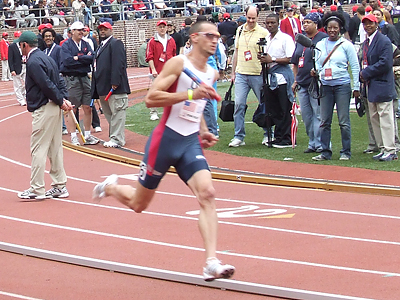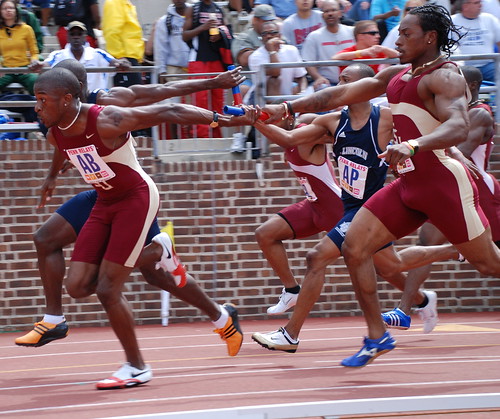RULES
The baton must be held the entire race. If the baton is dropped, pick it up and continue the race.
The incoming runner must hand the baton to the outgoing runner. You are not allowed to throw the baton.
The incoming and outgoing runners must stay within their lanes the entire race.
The baton must be exchanged within the exchange zones. Your body does not have to be in the exchange zone but the baton does.
When the race is over, do not drop or throw the baton. Either action will cause a disqualification.
If one athlete is wearing an undershirt or compression shorts, the others do not have to wear them.
If two or more athletes are wearing an undershirt or compression shorts, the others also have to wear them. The under-clothing also needs to match.
HOLDING A BATON IN THE BLOCKS
Put the baton in the appropriate starting hand. For the 4x100 and 4x200, the starting runner will hold the baton in their right hand. For the 4x400, the starting runner can hold the baton with their dominant hand.
Hold the baton by cupping the index finger and pushing it up into the crease between the thumb and the index finger. The baton will not touch the ground and will be hanging over the starting line. The baton can be in front of the starting line even though the hands cannot be. The outside 3 fingers will support the body just like a normal starting stance.
RUNNING WITH THE BATON
While holding the baton in the blocks, get in a normal stance.
Squeeze the baton into the crease between the thumb and the index finger. The baton is allowed to go across the line.
When the gun goes off, make a loose fist around the baton.
Keep a loose but solid grip on the baton. Do not squeeze it.
There are many ways to hold a baton. Do what is comfortable for you but also conducive to exchanging the baton.
If you need to adjust the baton, hit the baton against your hip. Do not hit it with your knee because the force will knock it out of your hand.


BLIND EXCHANGES (4x100, 4x200)
SETTING YOUR MARKS
Marks will be set from the little triangle.
The athlete will measure a certain amount of foot lengths away from the little triangle.
For the 4x100, the mark will be 16-20 foot lengths.
For the 4x200, the mark will be 10-14 foot lengths.
Mark will be an estimate and will constantly be adjusted. All athletes should be athletic and recognize changes from the norm.
All runners will stay in the designated lane the entire race.
STARTING POSITION
You will line-up with your back leg right in front of the tip of the small triangle.
If you are lining up on the straight, point your feet forward and stand on the inside of the lane.
If you are lining up on the curve, point your feet on the angle of the curve and stand on the inside of the lane.
Slightly turn your body and look to the inside to find the incoming runner.
The first 20 yards of the run should be exactly like coming out of the blocks.
EXCHANGING THE BATON
The baton should always stay in the middle of the track so no one has to reach across their body. A person receiving the baton with their right hand should be a little bit to the inside of the lane. A person receiving the baton with their left hand should be a little bit to the outside of the lane.
4x100: The incoming runner should continue sprinting until the baton has been exchanged completely.
The outgoing runner should take off sprinting as soon as the athlete hits their mark. Normal starting technique still applies.
The first and third runners will hold the baton in their right hand.
The second and fourth runners will hold the baton in their left hand.
When the incoming runner thinks they are in proper spacing, they will give a command to tell the outgoing runner to get the baton. They should give
the command when their baton arm is back so it will time up with the reaction time of the outgoing runner.
The incoming runner is in charge of placing the baton in the outgoing runner's hand. Take the baton across your body and extend your arm and
make sure the baton is parallel with the ground. Place the baton in the palm of the outgoing runner.
When the outgoing runner is commanded to receive the baton, they will raise their arm so it is parallel with the ground.
The incoming runner should try to run over the outgoing runner and the outgoing runner should try to run away from the incoming runner.
Hurdlers are usually very good at running the curves because it mimics the running pattern of the hurdles.
4x200: The incoming runner should continue sprinting until the baton has been exchanged completely.
The outgoing runner should take off at about 70% as soon as the athlete hits their mark. Normal starting technique still applies. The outgoing
runner cannot accelerate to full speed until the baton has been exchanged.
All runners will receive the baton with their right hand.
All runners will switch the baton while they are running and carry the baton in their left hand.
When the incoming runner thinks they are in proper spacing, they will give a command to tell the outgoing runner to get the baton. They should give
the command when their baton arm is back so it will time up with the reaction time of the outgoing runner.
The incoming runner is in charge of placing the baton in the outgoing runner's hand. Take the baton across your body and extend your arm and
make sure the baton is parallel with the ground. Place the baton in the palm of the outgoing runner.
When the outgoing runner is commanded to receive the baton, they will raise their arm so it is parallel with the ground.


OPEN EXCHANGES (4x400, 4x800)
SETTING YOUR MARKS
4x400: The first runner will stay in their designated lane the entire time.
The second runner will start at the 3 turn stagger. They will stay in their lane for the first 100m and then gradually cut in. Do not cut in too sharply.
The third and fourth runners will start at the solid line of triangles and stay in the inside lanes.
4x800: The first runner will gradually cut in after the second curve.
The rest of the runners will all start at the solid line of triangles and will stay in the inside lane the entire time.
STARTING POSITION
Your body and feet will be parallel with the starting line.
Get your body into a good athletic position and stick your butt out. This will keep the other runners from crowding you. If you are not on the inside lane, crowd the person on the inside of you.
If your team is in first, you will line up in the inside lane. The other teams will line up in the order of their place in the race.
If a team passes another team, the next runner should move themself into an advantageous position to receive the baton. It is up to the next runner to do this.
As the outgoing runners in front of you get their batons, scoot closer to the inside lane.
EXCHANGING THE BATON
Be aware of the surrounding runners so you avoid contact.
The incoming runner should continue sprinting until the baton has been exchanged completely.
The outgoing runner will start when they decide to and will start running at the appropriate speed. Read the incoming runner's body language to know when and how fast to take-off.
The outgoing runner will turn their upper body towards the incoming runner and put their left hand out with their their palm up.
Both runners should completely extend their arms so the outgoing runner can run a lesser distance.
The incoming runner will extend their arm and flatten the baton. The baton will be put into the palm of the outgoing runner's hand.
Once you get the baton, avoid the traffic and get to the inside lane as soon as possible. Only pass on the curve if you can blow by the person and get back into the inside lane.
Do not pass anyone on the curve unless you can blow past them. If you pass them, immediately get back to the inside.



VIDEOS
4 x 100 4 x 400 4 x 800
INFORMATION:
SCHEDULE
BOYS' ROSTER
GIRLS' ROSTER
BOYS' RESULTS
GIRLS' RESULTS
DEKE'S PAGE
www.favcsports.com
www.baumspage.com
http://www.trackstatsonline.com/Website/HOMEPAGE.cfm
RECORDS:
SCHOOL RECORDS
TRACK HONOR ROLL
CROSS COUNTRY HONOR ROLL
ANDERSON INVITE RECORDS
TECHNIQUE:
2010 TRACK MEET VIDEOS
DISCUS
DISTANCE
HIGH JUMP
HURDLES
LONG JUMP
POLE VAULT
RELAY EXCHANGES
SHOT PUT
STARTING TECHNIQUE AND RUNNING FORM
Comments (0)
You don't have permission to comment on this page.